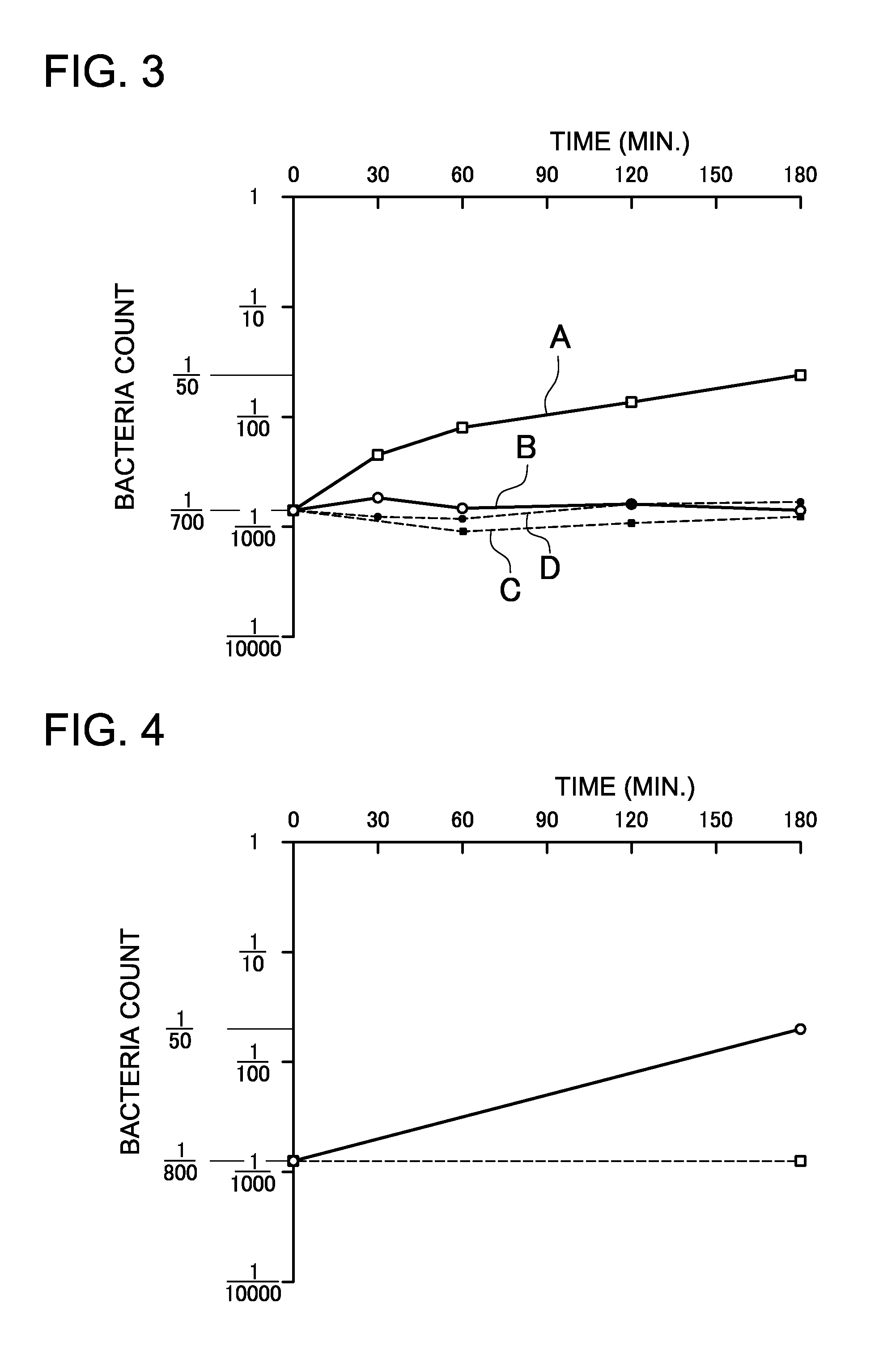Outdoor water treatment apparatus to kill bacteria with ultraviolet light
a technology of ultraviolet light and outdoor water treatment, which is applied in the direction of water/sewage treatment by oxidation, instruments, etc., can solve the problems of inactive microorganisms that cannot be recovered and multiplied, the cell dies, and the photoreactivation (also called photoreactivation) can occur, so as to reduce equipment costs, effectively kill bacteria, and effectively kill bacteria
- Summary
- Abstract
- Description
- Claims
- Application Information
AI Technical Summary
Benefits of technology
Problems solved by technology
Method used
Image
Examples
first embodiment
[First Embodiment]
[Construction of the Apparatus to Kill Bacteria with Ultraviolet Light]
[0057]As shown in FIG. 7, a plurality of UV LEDs 1 is disposed in a prescribed arrangement inside the case 3. The UV LEDs 1 are mounted in the case 3 via circuit boards 6 in an orientation that emits light directly downward. The UV LEDs 1 are (Nichia Corporation) devices with a primary emission peak of 365 nm, an emission spectrum with a 10 nm width at half-maximum, and an output intensity of 100 mW. The UV LEDs 1 are connected in series and parallel and connected to a power supply (Kikusui Electronics Corporation PAS 40-9). The power supply is a direct current (DC) power supply with output stabilization. The power supply is used in the constant current mode supplying a specified UV LED 1 current of 500 mA to attain an output intensity of 100 mW.
[0058]The exceptional antibacterial effects of the apparatus to kill bacteria with ultraviolet light described above are confirmed by the tests detailed...
second embodiment
[Second Embodiment]
[0072]Besides using V. parahaemolyticus bacteria instead of non-virulent E. coli bacteria as the indicator bacteria for outdoor water treatment and using UVA included in sunlight with a UV intensity of 0.30 mW / cm2 in the photoreactivation step after disinfection, the change in bacteria count for the second embodiment is determined in the same manner as in the first embodiment.
[0073]Experimental results for the second embodiment are shown in FIG. 3 (curves B and D). In this figure, the V. parahaemolyticus bacteria count is reduced to 1 / 700th in the disinfection step that shines UVA ultraviolet light with a primary emission peak of 365 nm and intensity of 70 mW / cm2. Subsequently in the photoreactivation step, the change in V. parahaemolyticus bacteria count is shown for exposure to UVA included in sunlight having a primary emission peak of 365 nm. Curve B of the graph shows the change in bacteria count for exposure to UV light with an intensity of 0.30 mW / cm2 in the...
third embodiment
[Third Embodiment]
[0074]The third embodiment uses the apparatus to kill bacteria with ultraviolet light shown in FIG. 8 to treat (bacterially) polluted water that is outdoors. The apparatus shown in FIG. 8 is provided with a plurality of UV LEDs 1 and UVC light sources 2 inside the case 3. In the disinfection step, UVA ultraviolet light with a primary emission peak of 365 nm and intensity of 70 mW / cm2 is irradiated via the UV LEDs 1 for 15 min. In the photoreactivation step after disinfection, the bacteria count is determined after 180 min exposure to UVA included in sunlight with an intensity of 0.30 mW / cm2.
[0075]Experimental results for the third embodiment are shown in FIG. 5. This figure shows the change in bacteria count in the photoreactivation step after reducing the bacteria population in polluted water to approximately 1 / 20th in the disinfection step. The solid line of the graph shows the change in bacteria count with exposure to UVA included in sunlight in the photoreactiv...
PUM
| Property | Measurement | Unit |
|---|---|---|
| wavelength | aaaaa | aaaaa |
| emission peak | aaaaa | aaaaa |
| emission peak | aaaaa | aaaaa |
Abstract
Description
Claims
Application Information
 Login to View More
Login to View More - R&D
- Intellectual Property
- Life Sciences
- Materials
- Tech Scout
- Unparalleled Data Quality
- Higher Quality Content
- 60% Fewer Hallucinations
Browse by: Latest US Patents, China's latest patents, Technical Efficacy Thesaurus, Application Domain, Technology Topic, Popular Technical Reports.
© 2025 PatSnap. All rights reserved.Legal|Privacy policy|Modern Slavery Act Transparency Statement|Sitemap|About US| Contact US: help@patsnap.com



